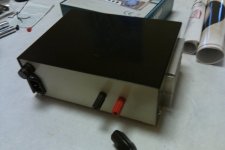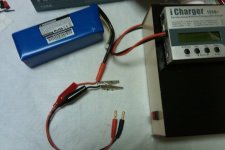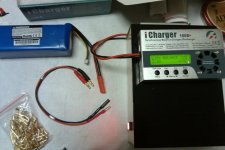Allex said:
Can someone explain how a charger work. You always see in the manuals for chargers that never use it to charge another types of batteries.
So, what is the difference between li-ion and a lipo charger, is it only that they have different cutoffs? Like 4.2 for lipo and a bit higher for li-ion? Or is it something else involved? If not than this means that you basically can connect any power source to the battery and disconnect manually when the cell hits 4.2?
Allex -
Answer To Your Question:
Yes, your first statement is correct:
a purpose-built charger for a particular chemistry would have different voltage and current cutoffs. You cannot connect
any power source to
any battery and disconnect it manually. You have to
match the power source voltage and current to the voltage and charge current for the battery. The purpose for this discussion topic is to show, in pictures, how to properly match a LiPo battery to a balance charger.
You can put gasoline in a diesel car or diesel in a gasoline car too. But the car will fail and not perform well. In the case of gasoline and diesel, the differences are clear because of the shared experience of many people. Now, everyone knows this is a foolish thing to do. It is similarly true with chargers and batteries, except the differences are very hard to see. Large, high-current Lithium batteries are new technology (did not exist when I got my engineering training) so I have carefully read about the experiences of the people here when charging and using LiPo, LiIon and learned from them.
Now, you can "kind of" match a charger to a battery and get some charge into a LiPo battery. But you have to be very specific about what you are doing.
Example 1: a 12V (peak 13.6V) PbSo battery charger re-used to charge a LiPo, it would "sort of" work. You could buy a 12v "nominal" LiPo pack (that would be a 3S) and charge it, but you would need to sit there and monitor the voltage and current with meters and shut it off yourself when the LiPo battery gets to the right voltage. (Cell voltage types have been extensively discussed on E-S so I won't repeat them here.)
End Example
But
no one here would ever advise you to do that. (any power source to a LiPo battery). LiPo can self-destruct if not properly charged. You cannot do as good a job as a computer-controlled charger or a purpose-built bulk charger. Even if you are careful and successful, you will not get good performance from the battery.
Example 2: Nissan LEAF: The Nissan LEAF is FILLED with Lithium batteries. And every cell has a BMS module monitoring the state of charge and health of that cell, and reporting that back to the car's computer system. The charging port parameters (voltage, current, control signals) are standardized by international agreement. In the case of the Nissan LEAF, it is impossible to charge the Lithium without a matched charger and without monitoring the voltage, current and temperature of the batteries.
End Example.
There are those who will challenge you and say "you have left out much detail from your question - get more specific!" But I am interpreting your question in this topic thread to mean "Why are you doing all this balance-charging stuff?" I say give you a quick answer to stimulate your thinking, then you will be able to get more specific with your questions.
Explanation: Balance LiPo Charging
Balance charging lets me SEE the charge on each cell and how the pack is accepting charge current. The balance charger gives me enough information to know that my expensive $42US pack is OK.
So it's like using a pearhead socket wrench for a hammer, when you would get better, safer results using the hammer. (don't ruin a good pearhead ratchet.

) Mixing LiPo with chargers not built for LiPo can ruin the battery, leave you stranded somewhere, or cause a fire and burn down your house.
So the reason for careful balance charging is to monitor and properly care for your expensive pack and to protect you and your house - to be as safe as possible during charging. LOTS of cautions about this on E-S, no reason to go into that here.
This balance charger (and others like it) monitor voltage, current, temperature and state-of-charge of the battery. It has a button to switch between all the different voltages and charge currents, so it
can be used with LiIon/LiPo/LiFe, NiMH/NiCd and Lead-Acid (Pb). It comes with a firmware disk. You upgrade the firmware and check/set the voltage settings when you get it. (I found mine to have both correct firmware and voltage settings.) The charger has a button where you can select each type of battery. The types it will charge are printed on the charger, underneath the big "iCharger 106B+" on the picture of the unboxing. One of the coolest features of this charger is that you can use software on your PC to monitor the rate of charge for each individual cell via the USB port.
It has a balancing port (a "standard" JST-XH connector) where wires from every cell attach, so that the charger can monitor the voltage on each cell. You have a button you can cycle through each battery type (or "chemistry") and the charger will choose the proper voltage, and more importantly, a "current taper". There is even a temp sensor port so the charger can taper off the current if the battery temperature gets too hot. If you use LiPo bricks in parallel, you can connect the entire parallel set to this charger, parallel the balancing leads, and charge the whole parallel pack.
Bulk LiPo Charging
You can buy a "bulk" charger for LiPo (say, from bmsbattery.com) and you tell them what voltage and chemistry of cell you have. they build the charger to match the desired ratings "hot off the charger". Even the bulk charger will taper off the current at the end of the charge and shut off automatically, making it safe to use with LiPo pack. It just doesn't give you as much control and information about the condition of the cells as a balancing charger does.
Many people on E-S will bulk charge most of the time, then balance charge every once in awhile, to keep all the cells in the pack at the right voltage. LiPo cells can get out of balance after awhile and one cell get "starved" for current. That will cause the pack to fail. So balance charging is a way of getting best performance out of expensive LiPo cells.
(Disclaimer: I am not affiliated with the mfr. of this charger, nor the vendor I bought it from. I'm only using it as an example of a computer controlled charger for the purposes of explanation. )






